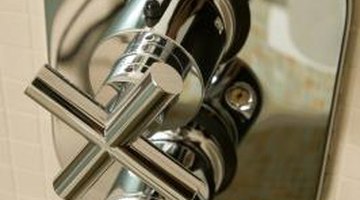Shower Faucets That Control Both Volume and Temperature
Every newly built shower requires at least one valve to control the flow and temperature of the water. There are numerous types of shower valves on the market, but not each type is necessarily the right kind for the shower you are building. Take your needs, the number of water surfaces, and the user of the bathroom into consideration when making your choice.
Pressure Balancing

Most people may not realize they already are familiar with the pressure-balancing valve. It is the most commonly sold and installed valve in bathrooms. It has one handle that provides a constant, steady stream of water to either a tub spout or showerhead. As you move the handle to the left, the water gets hotter. As it moves to the right, the water gets colder and eventually shuts off. The valve maintains the temperature of the water plus or minus three degrees at all times, by detecting changes in water pressure, and opening and closing to compensate. While some pressure-balancing valves used in stall showers allow you to adjust the volume of the water, this function is limited and not available with all models.
Thermostatic Valves
Plan on installing a thermostatic valve system in your shower if you plan on installing multiple showerheads or body sprays. Thermostatic valves control the temperature of the water in the shower, but do not affect the volume. Each separate water source in the shower, from a tub spout to a hand shower, gets its own volume control. Set the temperature of the shower to a precise degree on the thermostatic valve, then turn on the volume control valve for each of the water sources you plan on using. This method gives you the greatest control in both volume and temperature for the entire shower.
Dual Pressure Balancing Valves
If you enjoy the ability to control the temperature and volume of your shower separately, but want the convenience of one valve and the safety of a pressure-balancing system, consider a dual pressure-balancing valve. Pressure-balancing valves adjust to temperature changes in the bathroom, such as a toilet flushing, faster than thermostatic valves, which can mean less chance of scalding. A dual pressure-balancing valve uses the pressure-balancing system to control the temperature of the water after the temperature has been set. Set the temperature of the water on the top half of the valve, then turn on the volume with the lower half, allowing you greater control of both temperature and flow.
Integrated Thermostatic and Volume Controls
Pressure-balancing valves offer greater protection against scalds, but they aren't as precise in temperature setting, nor do they often have as great a range of temperatures with the ability to set the temperature of the shower more than 100 degrees Fahrenheit. Thermostatic valves do offer those capabilities. If you have only one showerhead and don't require a separate volume control from the thermostatic valve, consider getting an integrated valve. Integrated valves offer separate temperature and volume control on the same valve, using two different handles -- one for each purpose.
References
Writer Bio
Sarabeth Asaff has worked in and has written about the home improvement industry since 1995. She has written numerous articles on art, interior design and home improvements, specializing in kitchen and bathroom design. A member in good standing with the National Kitchen and Bath Association, Asaff has working knowledge of all areas of home design.
Photo Credits
- Jupiterimages/Photos.com/Getty Images
More Articles



